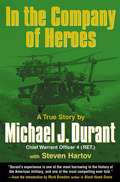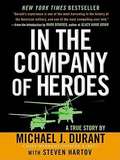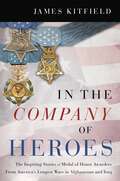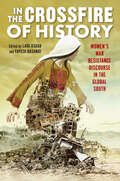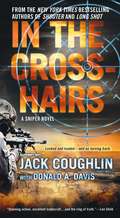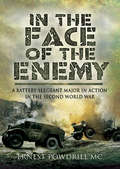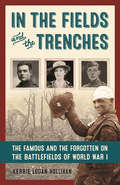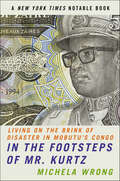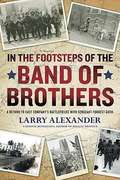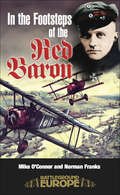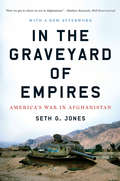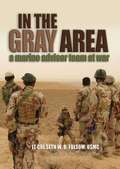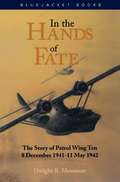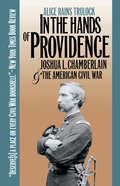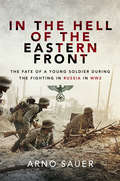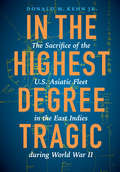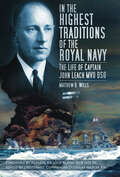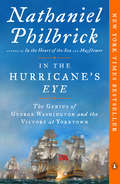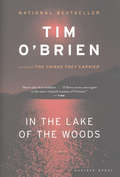- Table View
- List View
In the Commodore's Hands
by Mary NicholsStowaway...or wife! Commodore John Drymore's mission is clear. Sail to France, rescue Comte Giradet from prison and bring him and his daughter back to England safely. But Lisette Giradet defies the Commodore at every turn and soon gets under his skin more deeply than the bullet in his arm. Desperate to rescue her brother from the guillotine, Lisette smuggles herself back on board ship. With her life in jeopardy, she's given no choice-she must assume the role of the commodore's wife!
In the Company of Heroes
by Michael J. Durant Steven HartovFrom School Library Journal Adult/High School-A decade ago, Durant and his crew were shot down while flying a U.S. Army Special Operations Black Hawk helicopter in the heart of Mogadishu. The only survivor after a firefight with hostile forces of warlord Mohamed Farah Aidid, the author recounts the conditions of his 11 days in captivity, with experiences that ranged from heroic to gruesome, harrowing, bizarre, and compassionate. Suffering severe injuries to his back, leg, and face, moved under guard through a sequence of rudimentary facilities in a volatile combat environment, and facing the deadly risk of discovery by rival clans, Durant became a political pawn receiving global media attention.
In the Company of Heroes: A True Story Of Black Hawk Pilot Michael Durant And The Men Who Fought And Fell At Mogadishu (Americana Ser.)
by Michael J. Durant Steven HartovIn the autumn of 1993, American special forces were dispatched to the famine-stricken land of Somalia. Their intervention in this war-torn country was the most dramatic US military action since Vietnam. A routine mission went horribly wrong when Michael Durant's Black Hawk helicopter was shot down over Mogadishu and he was quickly surrounded by Somali troops and taken captive. The brutal torture he underwent was made all too clear to the world when his coerced statements were broadcast on live television and his battered face appeared on the cover of magazines around the globe. Michael Durant's ordeal was first described in Mark Bowden's international bestseller Black Hawk Down and the critically acclaimed film of the same name. This, his first-person gripping account tells of bravery under fire, torture, imprisonment, and the terrifying day by day reality for a soldier, unarmed and helpless in enemy hands, fighting to survive.
In the Company of Heroes: The Inspiring Stories of Medal of Honor Recipients from America's Longest Wars in Afghanistan and Iraq
by James KitfieldAn award-winning military journalist tells the amazing stories of twenty-five soldiers who've won the Medal of Honor, the nation's highest military award. In the Company of Heroes will feature in-depth narrative profiles of the twenty-five post-9/11 Medal of Honor awardees who served in Afghanistan and Iraq. This book will focus on the stories of these extraordinary people, expressed in their own voices through one-on-one interviews, and in the case of posthumous awards, through interviews with their brothers in arms and their families. The public affairs offices of the Joint Chiefs of Staff and the individual armed services, as well as the Congressional Medal of Honor Society, have expressed their support for this project.Stories include Marine Corps Corporal William "Kyle" Carpenter, who purposely lunged toward a Taliban hand grenade in order to shield his buddy from the blast; Navy SEAL team leader Britt Slabinski, who, after being ambushed and retreating in the Hindu Kush, returned against monumental odds in order to try to save one of his team who was inadvertently lost in the fight; and Ranger Staff Sergeant Leroy Petry, who lunged for a live grenade, threw it back at the enemy, and saved his two Ranger brothers.
In the Crossfire of History: Women's War Resistance Discourse in the Global South (War Culture)
by Matthew Spencer Lava Asaad Doaa Omran Farzana Akhter Margaret Hageman Nyla Khan Shafinur Nahar Carolyn Ownbey Moumin Quazi Lucia Garcia-Santana Stefanie SevcikIn the global south, women have and continue to resist multiple forms of structural violence. The atrocities committed against Yazidi women by ISIS have been recognized internationally, and the Nobel Peace Prize awarded to Nadia Murad in 2018 was a tribute to honor women whose bodies have been battered in the name of race, nationality, war, and religion. In the Crossfire of History:Women's War Resistance Discourse in the Global South is an edited collection that incorporates literary works, testimonies, autobiographies, women’s resistance movements, and films that add to the conversation on the resilience of women in the global south. The collection focuses on Palestine, Kashmir, Syria, Kurdistan, Congo, Argentina, Central America, Sri Lanka, and Bangladesh. The essays question historical accuracy and politics of representation that usually undermine women’s role during conflict, and they reevaluate how women participated, challenged, sacrificed, and vehemently opposed war discourses that erase women’s role in shaping resistance movements. The transformative mode of these examples expands the definition of heroism and defiance. To prevent these types of heroism from slipping into the abyss of history, this collection brings forth and celebrates women’s fortitude in conflict zones. In the Crossfire of History shines a light onwomen across the globe who are resisting the sociopolitical and economic injustices in their nation-states.
In the Crosshairs: A Sniper Novel (Kyle Swanson Sniper Novels #10)
by Sgt. Jack CoughlinThe Central Intelligence Agency is under attack, and so is its top field operative, Kyle Swanson. The highly decorated former Marine Corps gunnery sergeant is attending the funeral of a friend when a terrorist blows up the grave. A week later, he narrowly survives a grenade attack in Berlin. In Washington, Congress is being told that Swanson has been turned, his private employer is corrupt, and the Agency itself cannot be trusted. Swanson is assigned to find the root of the problem and is partnered up with Luke Gibson, a skilled operative rated as being almost as good as Swanson.They are looking for assassin Nicky Marks, who also was a CIA shooter but now works for a shadowy power broker known as The Prince. But before Kyle and Luke can eliminate the threat, they must identify and find the man who wants them dead. That takes them from the pink poppy fields of Afghanistan to the jungles of Southeast Asia and the streets of America as they learn that the Prince is the ruthless kingpin of a global drug empire that uses CIA planes to transport opium and heroin. Swanson also lines up a secret partner, the beautiful widow of his friend whose grave was desecrated in Mexico, the sharpshooting former commando Beth Ledford, who has her own agenda of pure retribution. Kyle Swanson, at the worst possible moment in a combat showdown, must decide: Do you trust your partner, and if so, which one?
In the Face of the Enemy: A Battery Sergeant Major in Action in the Second World War
by Ernest PowdrillIn Part One Powdrill describes his experiences in France during &‘the Phoney War and then their baptism by fire in May 1940, culminating in the evacuation from Dunkirk having left their disabled guns behind. Ernest was wounded but many of his colleagues were killed by ferocious German counter-battery fire. Part 2 tells a very different story in more detail. By now a Sergeant Major in an armoured tracked regiment, the author fought through from the Normandy beaches to the River Maas. He describes the near constant action in graphic terms. In the Face of the Enemy is a splendid soldiers story full of understatement and atmosphere. Success is tinged with sadness for lost comrades and admiration for his fellow men.
In the Fields and the Trenches: The Famous and the Forgotten on the Battlefields of World War I
by Kerrie HollihanFrom a Hall of Fame pitcher to a U.S. president, learn what an incredible impact World War I made on young men and women When it started, many thought the Great War would be a great adventure. Yet as those who saw it up close learned, it was anything but. In the Fields and the Trenches traces the stories of 18 young idealists swept into the brutal conflict, many of whom would go on to become well-known 20th-century figures in film, science, politics, literature, and business. Writer J. R. R. Tolkien was a signals officer with the British Expeditionary Force and fought at the Battle of the Somme. Scientist Irène Curie helped her mother Marie run 20 French field hospitals. Actor Buster Keaton left Hollywood after being drafted into the army's 40th Infantry Division. And all four of Theodore Roosevelt's sons fought in Europe, though one did not return. With World War I as a backdrop, readers will encounter heroes, cowards, comics, and villains who participated in this life-changing event. Author Kerrie Logan Hollihan uses extensive original material, from letters sent from the frontlines to personal journals, to bring these men and women back to life. And though their stories are a century old, they convey modern, universal themes of love, death, power, greed, courage, hate, fear, family, friendship, and sacrifice.
In the Fire of the Eastern Front (Stackpole Military History Series)
by Hendrick C. VertonExtraordinary story of a Dutch volunteer in the Waffen-SS. Vivid details on SS training and combat on the Eastern Front. Account of the little-known siege of Breslau in early 1945.
In the Footsteps of Mr. Kurtz: Living on the Brink of Disaster in Mobutu's Congo
by Michela WrongKnown as "the Leopard," the president of Zaire for thirty-two years, Mobutu Sese Seko, showed all the cunning of his namesake -- seducing Western powers, buying up the opposition, and dominating his people with a devastating combination of brutality and charm. While the population was pauperized, he plundered the country's copper and diamond resources, downing pink champagne in his jungle palace like some modern-day reincarnation of Joseph Conrad's crazed station manager.Michela Wrong, a correspondent who witnessed Mobutu's last days, traces the rise and fall of the idealistic young journalist who became the stereotype of an African despot. Engrossing, highly readable, and as funny as it is tragic, In the Footsteps of Mr. Kurtz assesses the acts of the villains and the heroes in this fascinating story of the Democratic Republic of Congo.
In the Footsteps of the Band of Brothers
by Larry AlexanderA tribute to World War II heroism from the national bestselling author of Biggest Brother. The paratroopers of Easy Company, 101st Airborne Division, have come to symbolize the incredible bravery and heroism shown by the greatest generation in World War II. on the eve of the 65th anniversary of the Allies' victory in Europe, author Larry Alexander crosses an ocean and a continent to discover just what made the Band of Brothers special. Accompanied by his friend Forrest Guth, an easy Company veteran on his final tour in Europe, Alexander explores the living history of the places where American soldiers went into action, and reveals what makes this story so meaningful for us today. Part travelogue, part historical perspective, In the Footsteps of the Band of Brothers is an unforgettable memorial to the men who fell in action, and a tribute to the veterans who are still with us. .
In the Footsteps of the Red Baron (Battleground Europe)
by Mike O'Connor Norman FranksManfred von Richthofen became a fighter pilot on the Western Front in August 1916. By January 1917, Richthofen had shot down fifteen aircraft had been appointed commander of his own unit. He painted the fuselage of his Albatros D-III a bright red and was nicknamed the Red Baron. In June 1917, Richthofen was appointed commander of the German Flying Circus. Made up of Germany's top fighter pilots, this new unit was highly mobile and could be quickly sent to any part of the Western Front where it was most needed. Richthofen and his pilots achieved immediate success during the air war over Ypres during August and September. Manfred von Richthofen was killed on 21st April 1918. Richthofen had destroyed 80 allied aircraft, the highest score of any fighter pilot during the First World War. This book is divided into three sectors of the WWI front line in which von Richthofen operated. Each area is conveniently reached within hours. Airfield sites, memorials and the graves of Manfred's famous victims are described and directions for the battlefield walker are included with information on related museums and historic sites with special association with this most famous of fighter pilots.
In the Full Light of the Sun
by Clare ClarkIn the Full Light of the Sun follows the fortunes of three Berliners caught up in a devastating scandal of 1930s' Germany. It tells the story of Emmeline, a wayward, young art student; Julius, an anxious, middle-aged art expert; and a mysterious art dealer named Rachmann who are at the heart of Weimar Berlin at its hedonistic, politically turbulent apogee and are whipped up into excitement over the surprising discovery of thirty-two previously unknown paintings by Vincent van Gogh.Based on a true story, unfolding through the subsequent rise of Hitler and the Nazis, this gripping tale is about beauty and justice, and the truth that may be found when our most treasured beliefs are revealed as illusions. Brilliant on authenticity, vanity and self-delusion, it is a novel for our times.
In the Full Light of the Sun
by Clare ClarkIn the Full Light of the Sun follows the fortunes of three Berliners caught up in a devastating scandal of 1930s' Germany. It tells the story of Emmeline, a wayward, young art student; Julius, an anxious, middle-aged art expert; and a mysterious art dealer named Rachmann who are at the heart of Weimar Berlin at its hedonistic, politically turbulent apogee and are whipped up into excitement over the surprising discovery of thirty-two previously unknown paintings by Vincent van Gogh.Based on a true story, unfolding through the subsequent rise of Hitler and the Nazis, this gripping tale is about beauty and justice, and the truth that may be found when our most treasured beliefs are revealed as illusions. Brilliant on authenticity, vanity and self-delusion, it is a novel for our times.
In the Graveyard of Empires: America's War in Afghanistan
by Seth G. JonesA definitive account of the American experience in Afghanistan from the rise of the Taliban to the depths of the insurgency. After the swift defeat of the Taliban in 2001, American optimism has steadily evaporated in the face of mounting violence; a new "war of a thousand cuts" has now brought the country to its knees. In the Graveyard of Empires is a political history of Afghanistan in the "Age of Terror" from 2001 to 2009, exploring the fundamental tragedy of America's longest war since Vietnam. After a brief survey of the great empires in Afghanistan--the campaigns of Alexander the Great, the British in the era of Kipling, and the late Soviet Union--Seth G. Jones examines the central question of our own war: how did an insurgency develop? Following the September 11 attacks, the United States successfully overthrew the Taliban regime. It established security throughout the country--killing, capturing, or scattering most of al Qa'ida's senior operatives--and Afghanistan finally began to emerge from more than two decades of struggle and conflict. But Jones argues that as early as 2001 planning for the Iraq War siphoned off resources and talented personnel, undermining the gains that had been made. After eight years, he says, the United States has managed to push al Qa'ida's headquarters about one hundred miles across the border into Pakistan, the distance from New York to Philadelphia. While observing the tense and often adversarial relationship between NATO allies in the Coalition, Jones--who has distinguished himself at RAND and was recently named by Esquire as one of the "Best and Brightest" young policy experts--introduces us to key figures on both sides of the war. Harnessing important new research and integrating thousands of declassified government documents, Jones then analyzes the insurgency from a historical and structural point of view, showing how a rising drug trade, poor security forces, and pervasive corruption undermined the Karzai government, while Americans abandoned a successful strategy, failed to provide the necessary support, and allowed a growing sanctuary for insurgents in Pakistan to catalyze the Taliban resurgence. Examining what has worked thus far--and what has not--this serious and important book underscores the challenges we face in stabilizing the country and explains where we went wrong and what we must do if the United States is to avoid the disastrous fate that has befallen many of the great world powers to enter the region.
In the Gray Area
by Seth W. FolsomIn the Gray Area builds on Seth Folsom's earlier award-winning memoir, The Highway War, which described his 2003 command of one of the first Marine light armored reconnaissance battalion companies to march on Baghdad. In February 2008, he was deployed to Iraq again as the leader of a U.S. Marine advisor team embedded with an Iraqi army infantry battalion. In this new work, Folsom frankly addresses the realities of the Marines' mission as he reflects on challenges they and their Iraqi counterparts faced in their struggle to gain control of al-Anbar province. He explores the bonds he formed with his men, the "Outlanders," and the tenuous relationships forged between the American and Iraqi soldiers whose cultures were so vastly different. The author creates a compelling picture of the obstacles faced by both as they lived, ate, and fought side-by-side.The Highway War was lauded for its insights about how a young combat leader copes with his own vulnerabilities while publicly presenting a tough persona. In the Gray Area, Folsom shows a now more mature commander thoughtfully evaluating the situation at a time when the Iraqi army is on the cusp of independence from its American partners. He further reflects on the difficulties posed by a possibly premature American departure from Iraq and questions if the advisor mission is really the key to an American exit of Iraq.
In the Hands of Fate
by Dwight R. MessimerPatrol Wing Ten was the only U.S. Navy aviation unit to fight the Japanese in the early weeks of World War II, and the daring exploits of its PBY scout-plane pilots offer a dramatic tale of heroism, duty, and controversy. Poorly equipped and dead tired from flying back-to-back patrols with no fighter cover, the men lost sixty-six percent of their aircraft in just eight weeks as they took on an enemy that outnumbered them nearly 1,000 to one. This forceful narrative places the reader right in the midst of their courageous battle. Dwight Messimer's aggressive research on the topic has resulted in a work that provides moving details to their desperate but valiant acts against the seemingly invincible Japanese juggernaut that swept across the southwest Pacific at the opening of the war.By Christmas Day in 1941, Patrol Wing Ten was forced to split into two groups, one fighting an air and sea campaign in Java, the other fighting as infantry on Bataan and Corregidor. Moving back and forth between the two groups, Messimer skillfully interweaves their experiences with the major events of the overall war. He uses material from the fifty survivors he managed to track down and deftly captures their ability to maintain a sense of humor in the face of overwhelming danger. The more than one hundred personal and official documents uncovered during years of research reveal new information relating to technical points about the planes, facts verified by the PBY crews that do not agree with popularly accepted ideas. To those who believe the wing accomplished nothing--and this group includes many pilots--Messimer argues that while attempts to bomb the Japanese fleet proved futile because the PBYs were unsuitable for such a task, the wing's rescue and evacuation missions saved many lives. The airdales themselves were not so lucky. When Corregidor fell, nearly half of them were captured and many died in captivity.
In the Hands of Providence
by Alice Rains TrulockDeserve[s] a place on every Civil War bookshelf.--New York Times Book Review "[Trulock] brings her subject alive and escorts him through a brilliant career. One can easily say that the definitive work on Joshua Chamberlain has now been done.--James Robertson, Richmond Times-Dispatch"An example of history as it should be written. The author combines exhaustive research with an engaging prose style to produce a compelling narrative which will interest scholars and Civil War buffs alike.--Journal of Military History"A solid biography. . . . It does full justice to an astonishing life.--Library Journal This remarkable biography traces the life and times of Joshua L. Chamberlain, the professor-turned-soldier who led the Twentieth Maine Regiment to glory at Gettysburg, earned a battlefield promotion to brigadier general from Ulysses S. Grant at Petersburg, and was wounded six times during the course of the Civil War. Chosen to accept the formal Confederate surrender at Appomattox, Chamberlain endeared himself to succeeding generations with his unforgettable salutation of Robert E. Lee's vanquished army. After the war, he went on to serve four terms as governor of his home state of Maine and later became president of Bowdoin College. He wrote prolifically about the war, including The Passing of the Armies, a classic account of the final campaign of the Army of the Potomac.
In the Hell of the Eastern Front: The Fate of a Young Soldier During the Fighting in Russia in WW2
by Arno SauerA Nazi infantryman recalls the horrors of combat against the Soviet Union in this WWII memoir as told to his son.Friedrich “Fritz” Sauer was posted to the Eastern Front in 1942. A soldier in the 132nd Infantry Division, he was deployed in Hitler’s grand invasion of Russia. But instead of the swift knockout blow the Germans had anticipated, Operation Barbarossa ground on for almost four years. Sent first to the Crimea and then the region around Leningrad, Fritz experienced horrors of all kinds. In this memoir, Fritz recalls losing his best friend to a sniper, rescuing the body of a fallen comrade from No Man’s Land, enduring Soviet tank assaults, and his own wounding during a counterattack. Fritz was later transferred to a tank assault regiment where, on a mission to contact another unit, he lost his way in the snow. After sheltering with a farmer’s family, Fritz headed west to flee the advancing Red Army. His subsequent journey home took many twists and turns.
In the Highest Degree Tragic: The Sacrifice of the U.S. Asiatic Fleet in the East Indies during World War II
by Donald M. Kehn Jr.In the Highest Degree Tragic tells the heroic story of the U.S. Asiatic Fleet’s sacrifice defending the Dutch East Indies from the Japanese in the first three months of the Pacific War. Donald M. Kehn Jr.’s comprehensive narrative history of the operations involving multiple ships and thousands of men dramatically depicts the chaotic nature of these battles. His research has uncovered evidence of communications failures, vessels sinking hundreds of miles from where they had been reported lost, and entire complements of men simply disappearing off the face of the earth. Kehn notes that much of the fleet went down with guns blazing and flag flying, highlighting, where many others have failed to do so, the political and strategic reasons for the fleet’s deployment to the region in the first place. In the Highest Degree Tragic rectifies the historical record, showcasing how brave yet all-too-human sailors and officers carried out their harrowing tasks. Containing rare first-person accounts and anecdotes, from the highest command echelons down to the lowest enlisted personnel, Kehn’s book is the most comprehensive and exhaustive study to date of this important part of American involvement in World War II.
In the Highest Traditions of the Royal Navy: The Life of Captain John Leach MVO DSO
by Matthew B WillsOn 10 December 1941, the Royal Navy battleship HMS Prince of Wales was sunk by Japanese bombers in the South China Sea. Amongst the several hundred men who went down with her was her Captain, John Leach, who had fought against frightful odds and to the very end made the best of an impossible situation with courage and calmness. He truly embodied ‘the highest traditions of the Royal Navy’. Author Matthew B. Wills analyses the influences that shaped John Leach and led him ultimately to his heroic end: his time at Royal Naval College Osborne and Britannia Royal Naval College Dartmouth and his baptism of fire when he survived a direct shell hit to the bridge where he was standing. He describes Leach’s role in command during the Battle of the Denmark Strait, during which the Prince of Wales inflicted damage on the Bismarck that contributed to her later destruction ? and then the ill-fated mission to Singapore as part of Force Z, an attempt to intercept Japanese landings in Malaya.
In the Hurricane's Eye: The Genius of George Washington and the Victory at Yorktown (The American Revolution Series #3)
by Nathaniel PhilbrickThe thrilling story of the year that won the Revolutionary War from the New York Times bestselling author of In the Heart of the Sea and Valiant Ambition <p><p>In the fall of 1780, after five frustrating years of war, George Washington had come to realize that the only way to defeat the British Empire was with the help of the French navy. <p><p>But as he had learned after two years of trying, coordinating his army's movements with those of a fleet of warships based thousands of miles away was next to impossible. And then, on September 5, 1781, the impossible happened. Recognized today as one of the most important naval engagements in the history of the world, the Battle of the Chesapeake--fought without a single American ship--made the subsequent victory of the Americans at Yorktown a virtual inevitability. <p><p>In a narrative that moves from Washington's headquarters on the Hudson River, to the wooded hillside in North Carolina where Nathanael Greene fought Lord Cornwallis to a vicious draw, to Lafayette's brilliant series of maneuvers across Tidewater Virginia, Philbrick details the epic and suspenseful year through to its triumphant conclusion. A riveting and wide-ranging story, full of dramatic, unexpected turns, In the Hurricane's Eye reveals that the fate of the American Revolution depended, in the end, on Washington and the sea. <P><b>A New York Times Bestseller</b>
In the Kaiser’s Clutch
by Kathleen KarrStarring in an anti-German World War I propaganda serial in the days before the "talkies," fifteen-year-old twins Fitzhugh and Nelly Dalton find their screen adventures paling in comparison to a real-life mystery.
In the King's Name
by Alexander KentFilled with high-seas intrigue and sharp tensions, this nautical novel takes an intense voyage into the heart of Napoleonic-era Africa. The year is 1819 and Captain Adam Bolitho has been sent on an urgent but risky mission to make a fast passage from Plymouth to Freetown, West Africa, with secret orders for the senior officer stationed there. Due to the slave trade being declared illegal, ships in every harbor are waiting to be scrapped and officers have been cut loose without hope of future commands, thus Adam soon finds himself the object of envy and jealousy. In Africa he discovers unexpected allies and faces an enemy far more powerful and ruthless than any he has known before.
In the Lake of the Woods: A Novel
by Tim O'BrienA politician&’s past war crimes are revealed in this psychologically haunting novel by the National Book Award–winning author of The Things They Carried. Vietnam veteran John Wade is running for senate when long-hidden secrets about his involvement in wartime atrocities come to light. But the loss of his political fortunes is only the beginning of John&’s downfall. A retreat with his wife, Kathy, to a lakeside cabin in northern Minnesota only exacerbates the tensions rising between them. Then, within days of their arrival, Kathy mysteriously vanishes into the watery wilderness. When a police search fails to locate her, suspicion falls on the disgraced politician with a violent past. But when John himself disappears, the questions mount—with no answers in sight. In this contemplative thriller, acclaimed author Tim O&’Brien examines America&’s legacy of violence and warfare and its lasting impact both at home and abroad.

